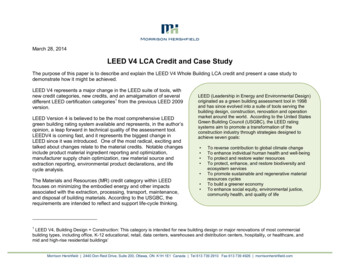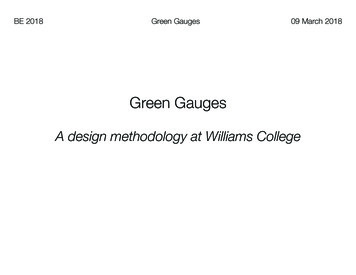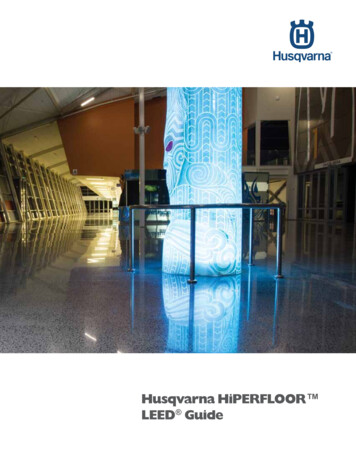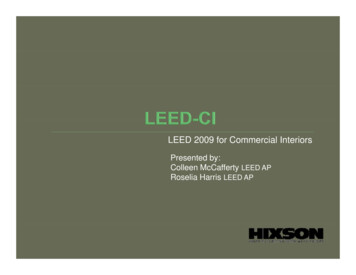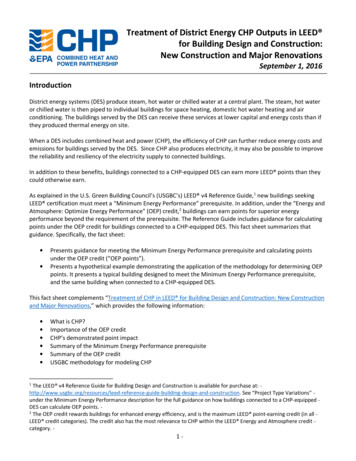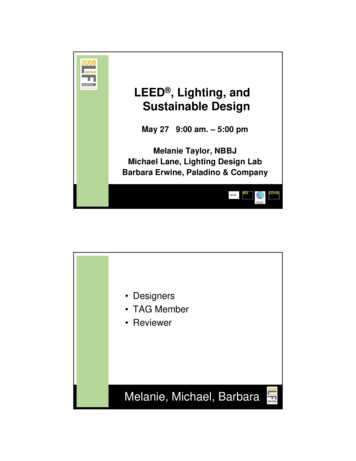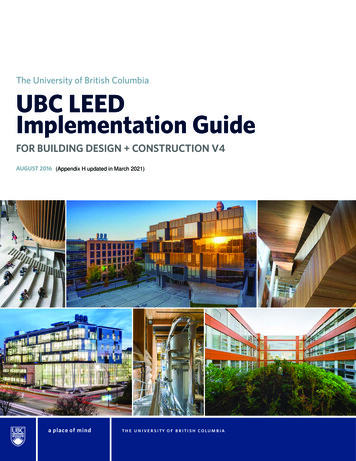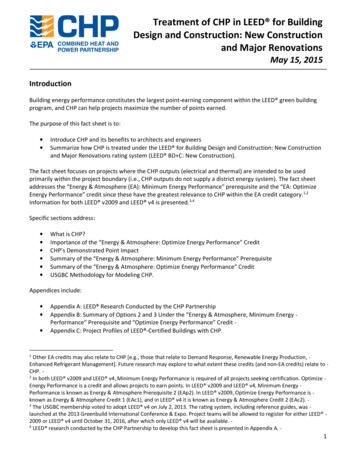
Transcription
Treatment of CHP in LEED for BuildingDesign and Construction: New Constructionand Major RenovationsMay 15, 2015IntroductionBuilding energy performance constitutes the largest point-earning component within the LEED green buildingprogram, and CHP can help projects maximize the number of points earned.The purpose of this fact sheet is to: Introduce CHP and its benefits to architects and engineersSummarize how CHP is treated under the LEED for Building Design and Construction: New Constructionand Major Renovations rating system (LEED BD C: New Construction).The fact sheet focuses on projects where the CHP outputs (electrical and thermal) are intended to be usedprimarily within the project boundary (i.e., CHP outputs do not supply a district energy system). The fact sheetaddresses the “Energy & Atmosphere (EA): Minimum Energy Performance” prerequisite and the “EA: OptimizeEnergy Performance” credit since these have the greatest relevance to CHP within the EA credit category.1,2Information for both LEED v2009 and LEED v4 is presented.3,4Specific sections address: What is CHP?Importance of the “Energy & Atmosphere: Optimize Energy Performance” CreditCHP’s Demonstrated Point ImpactSummary of the “Energy & Atmosphere: Minimum Energy Performance” PrerequisiteSummary of the “Energy & Atmosphere: Optimize Energy Performance” CreditUSGBC Methodology for Modeling CHP.Appendices include: Appendix A: LEED Research Conducted by the CHP PartnershipAppendix B: Summary of Options 2 and 3 Under the “Energy & Atmosphere, Minimum Energy Performance” Prerequisite and “Optimize Energy Performance” Credit Appendix C: Project Profiles of LEED -Certified Buildings with CHP.1Other EA credits may also relate to CHP [e.g., those that relate to Demand Response, Renewable Energy Production, Enhanced Refrigerant Management]. Future research may explore to what extent these credits (and non-EA credits) relate to CHP. 2In both LEED v2009 and LEED v4, Minimum Energy Performance is required of all projects seeking certification. Optimize Energy Performance is a credit and allows projects to earn points. In LEED v2009 and LEED v4, Minimum Energy Performance is known as Energy & Atmosphere Prerequisite 2 (EAp2). In LEED v2009, Optimize Energy Performance is known as Energy & Atmosphere Credit 1 (EAc1), and in LEED v4 it is known as Energy & Atmosphere Credit 2 (EAc2). 3The USGBC membership voted to adopt LEED v4 on July 2, 2013. The rating system, including reference guides, was launched at the 2013 Greenbuild International Conference & Expo. Project teams will be allowed to register for either LEED 2009 or LEED v4 until October 31, 2016, after which only LEED v4 will be available. 4LEED research conducted by the CHP Partnership to develop this fact sheet is presented in Appendix A. 1
What is CHP? CHP is an efficient and clean approach togenerating electric power and usefulthermal energy from a single fuel source(most often natural gas). CHP is usedeither to replace or supplementconventional separate heat and power(SHP) (typically purchased electricity froma utility and an onsite boiler). Instead ofpurchasing electricity from the local utilityand burning fuel in an on-site furnace orboiler to produce thermal energy, afacility can use CHP to provide bothenergy services in one energy-efficientstep.CHP requires less fuel to produce a given energy outputBuildings that utilize CHP can enjoy thefollowing benefits: Lower energy costs. CHP can save buildings considerable money on their energy bills due to its highefficiency and can provide a hedge against unstable energy costs.Reduced air emissions. Because less fuel is burned to produce each unit of energy output, CHP reducesemissions of greenhouse gases and other air pollutants.Reliable energy supply. CHP can be designed to provide high-quality electricity and thermal energy to abuilding regardless of what might occur on the power grid, such as a grid outage.CHP can be utilized in a variety of applications that have significant electric and thermal loads. CHP has a proventrack record of success providing electricity, steam, and hot water to applications such as hospitals, schools,university campuses, hotels, nursing homes, office buildings and apartment complexes.Typical CHP ConfigurationCHP systems generate electricity by burning fuel (typically natural gas) to generate electricity and then use aheat recovery unit to capture heat from the combustion system's exhaust stream. This heat is converted intouseful thermal energy, usually in the form of steam or hot water.2
Is My Building a Good Candidate for CHP? Are average electricity rates more than .07/ kWh (including generation, transmission, and distribution)?Is there a need to reduce energy costs or minimize expose to possible future increases in electricity rates?Is the building located in a deregulated electricity market?Is power reliability a concern? Would there be a substantial financial impact power went out?Does the building operate for more than 5,000 hours/year?Are there thermal loads throughout the year (including steam, hot water, chilled water, and hot air)?"Yes" answers to any of these of these questions suggests the building may be a good candidate for CHP.Importance of the “Energy & Atmosphere: Optimize Energy Performance” CreditThe Optimize Energy Performance credit rewards buildings for enhanced energy efficiency, and is the maximumLEED point-earning credit (in all LEED credit categories). Achieving all of the available Optimize Energy Performance credits would represent 47.5 percent (LEED v2009) and 45 percent (LEED v4) of the points needed to earn certification at the “LEED Certified ”level.Table 1 illustrates the importance of this credit in both LEED v2009 and LEED v4.Table 1: Importance of Energy & Atmosphere: Optimize Energy PerformanceLEED VersionTotal Number of PointsAvailableLEED v2009110Total Number of PointsNeeded to Earn LEED Certified *40LEED v411040Total Number of OptimizeEnergy PerformancePoints Available1918 (16 for Schools; 20 forHealthcare)*LEED Certified is the lowest level that can be achieved under LEED. LEED Silver is earned with 50 points; LEED Gold isearned with 60 points; LEED Platinum is earned with 80 points.CHP’s Demonstrated Point ImpactCHP’s efficiency and cost saving benefits can greatly contribute to a project’s ability to earn points under theOptimize Energy Performance credit. One of EPA’s CHP Partners calculated the point contribution for eightbuildings in design (as of October 2014), modeling each building twice—once using separate heat and power(SHP) and once using CHP. Table 2 shows the anticipated point impact CHP has on these eight buildings, whichranges from 5-9 additional points. For two of the projects (Buildings 7 and 8), the Minimum Energy Performanceprerequisite would not be met without the use of CHP.Differences in the point impact of CHP among the various buildings are due to building-specific variables includingthe performance parameters of the specific system, how many hours it runs, its power/heat ratio, and usablepower and heat outputs relative to the specific building loads.3
Table 2: CHP’s Demonstrated Point Impact on 8 High-Rise Residential BuildingsBuilding# of Apts.CHP Size/TypePts. w/out CHP1620130 kW Microturbine2234065 kW Microturbine23500200 kW Microturbine2410065 kW Microturbine1518565 kW Microturbine3625065 kW Microturbine17230200 kW Microturbine0*84075 kW Reciprocating Engine0** Would not meet Minimum Energy Performance Prerequisite without CHP.Pts. w/CHP810779794Estimate Energy Cost Savings and Points Achieved with CHPThe LEED CHP Calculator is an Excel-based tool that estimates the energy cost savings and Optimize EnergyPerformance points a building can achieve with CHP. The calculator is intended to be used by building designteams at the very early stages of building design to approximate the energy cost savings and LEED pointsfrom a CHP system. Users answer 8 simple questions about the Baseline Building energy use. Default values are available,but the user must know the baseline building’s average monthly electric and heating demands.The calculator then selects a CHP system based on user inputs and provides an annual estimate ofenergy cost savings with CHP compared to using SHP, as well as an estimate of the number ofOptimize Energy Performance points a building could achieve with CHP in both LEED v2009 andLEED v4.Download the LEED CHP Calculator.Summary of the “Energy & Atmosphere: Minimum Energy Performance” Prerequisite5The Minimum Energy Performance prerequisite (EAp2) must be met by all projects seeking LEED certification.LEED provides three compliance pathways for meeting EAp2 (certain compliance pathways—Options 2 and 3—are available only for certain building types, but Option 1 is available to all building types). However, only Option1 is likely to be considered for buildings with CHP systems as it allows projects with CHP to earn the most pointsfor its superior efficiency.6The compliance path (i.e., option) chosen for EAp2 must also be used to earn points under the Optimize EnergyPerformance credit. This is important because there are a significantly fewer points available under OptimizeEnergy Performance for the prescriptive paths—Option 2 has a maximum of 1 point available under LEED v20095LEED credit language for Minimum Energy Performance is available at:http://www.usgbc.org/node/1731017?return ere (LEED v2009) andhttp://www.usgbc.org/node/2613358?return /credits/new-construction/v4/energy-%26-atmosphere (LEED v4).6Projects with CHP are not precluded from using Options 2 or 3 to comply with EAp2, but it is unlikely that these optionswould be chosen given that their use for EAp2 also requires their use under the Optimize Energy Performance credit, wherefew points can be earned using these options.4
and 6 points available under LEED v4; Option 3 has a maximum of 3 points available (Option 3 is only availableunder LEED v2009).Of the three options, only Option 1 allows a project to use Option 1 under the Optimize Energy Performancecredit, with the potential to earn 19 points under LEED v2009 and 18 points under LEED v4. Use of Option 2 or3 to meet EAp2 limits the potential points that can be earned under the credit from zero to six points (dependingon the Option and the version of the rating system).Some building types may not have a choice and may have to comply with Option 1—both Options 2 and 3 areprescriptive compliance paths that are available only to specific building types and sizes.See Appendix B for information related to Options 2 and 3.Option 1: Whole Building Energy Simulation (Performance-based) LEED v2009o Projects must demonstrate savings of 10% (New Construction) or 5% (Major Renovations) in theproposed building (the “Design Building”) compared to a baseline case meeting the minimumrequirements of ASHRAE 90.1-2007 (the “Baseline Building”). This is done by using a model asdescribed in the Appendix G Performance Rating Method (PRM) of ASHRAE 90.1-2007.o The model described in the Appendix G PRM of ASHRAE 90.1-2007 is based on cost performanceof the building (e.g., the above referenced 10% [New Construction] savings are based on costrather than on energy or emissions savings. LEED v4o Projects must demonstrate savings of 5% (New Construction), 3% (Major Renovations), and 2%(Core and Shell) in the proposed building (the “Design Building”) compared to a baseline casemeeting the minimum requirements of ASHRAE 90.1-2010 (the “Baseline Building”). This is doneusing a model as described in the Appendix G PRM of ASHRAE 90.1-2010.o The model described in the Appendix G PRM of ASHRAE 90.1-2010 is based on cost performanceof the building (e.g., the above referenced 5% [New Construction] savings are based on costrather than on energy or emissions savings.Methodology for Modeling Combined Heat & Power for EAp2/c1 in LEED 2009The U.S. Green Building Council issued a guidance document presenting a methodology for incorporating CHP intothe simulation required through Option 1: Methodology for Modeling Combined Heat & Power for EAp2/c1 inLEED 2009 (onsite systems only).The U.S. Green Building Council indicates that this methodology also applies to LEED v4.It is available for download ling-combined-heat-amp-power-eap2c1-leed-20095
Summary of the “Energy & Atmosphere: Optimize Energy Performance” Credit7The Optimize Energy Performance credit (EAc1—LEED v2009, EAc2—LEED v4) includes the same compliancepathways as EAp2 (Option 3, however, is not available in LEED v4). Whichever compliance pathway is chosen forEAp2 is also used to earn points under the Optimize Energy Performance credit:See Appendix B for information related to Options 2 and 3.Option 1: Whole Building Energy Simulation (Performance-based) Option 1 is the only option that offers the potential to earn the maximum number of points available forthis credit.8 This requires whole building energy simulation using a computer model. As discussed above, to meet the prerequisite, EAp2, the project must reduce energy cost by a minimumpercentage compared to a Baseline Building meeting the minimum requirements of ASHRAE 90.1.o LEED v2009 – Projects must demonstrate savings of 10% (New Construction) or 5% (MajorRenovations) in the proposed building (the “Design Building”) compared to a baseline casemeeting the minimum requirements of ASHRAE 90.1-2007 (the “Baseline Building”). This is doneusing a model as described in the Appendix G PRM of ASHRAE 90.1-2007.o LEED v4 – Projects must demonstrate savings of 5% (New Construction), 3% (MajorRenovations), and 2% (Core and Shell) in the proposed building (the “Design Building”) comparedto a baseline case meeting the minimum requirements of ASHRAE 90.1-2010 (the “BaselineBuilding”). This is done using a model as described in the Appendix G PRM of ASHRAE 90.1-2010.**Once the prerequisite has been met, projects can then earn points for additional percentage increasesin energy cost reduction up to 19 points (LEED v2009) and 18 points (LEED v4). Table 3 presents thepoints available under the Optimize Energy Performance credit within the LEED BD C: New Constructionrating system (LEED v2009 and LEED v4).The energy modeling and documentation process is identical for EAp2 and Optimize Energy Performance, Option1. The exact reduction is established through running of the energy model.7LEED credit language for Optimize Energy performance is available at:http://www.usgbc.org/node/1731022?return ere (LEED v2009) andhttp://www.usgbc.org/node/2614273?return /credits/new-construction/v4/energy-%26-atmosphere (LEED v4).8Note that in LEED v2009, projects with an improvement over baseline of 50% or more may be considered for an additionalpoint under the Innovation in Design Category.6
Table 3: Points for Percentage Improvement in Energy Costs (New Construction) Percent Improvement 0%32%34%35%36%38%40%42%44%46%48%50%PointsLEED D v41234567891011--12--13--14--15--16--17--187
USGBC Methodology for Modeling CHPTo account for CHP in the energy model required for Option 1 ofEAp2 and the Optimize Energy Performance credit USGBCdeveloped the document Methodology for Modeling CombinedHeat & Power for EAp2/c1 in LEED 2009 (available lingcombined-heat-amp-power-eap2c1-leed-2009).9 The documentapplies only to on-site CHP systems which can either have thesame ownership as the project (Case 1) or different ownershipthan the project (Case 2).In accordance with the Appendix G PRM of ASHRAE 90.1, theparameters of the calculation of the CHP performance are asfollows:Case 1 – Same ownership, CHP inside project site boundaries CHP Methodology Basics: Energy requirements for the BaselineBuilding (which must meetrequirements of ASHRAE 90.1) areestimated using an energy model.Based on the model output, the costof purchased grid electricity andpurchased fuel to generate thermalenergy is calculated.The same process is used with theDesign Building (the one with CHP).The cost of fuel for the CHP and anypurchased electricity or fuel used toproduce thermal energy is calculated.Optimize Energy Performance pointsare calculated based on thepercentage reduction in energy costfor the Design Building.The Baseline Building heating and cooling plant utilizesthe backup energy source(s) of the Design Building, orelectricity if no backup source is present or specified.o For the electrical output of the CHP system the backup source is purchased electricity.o For the CHP thermal output, the backup energy source in the context of the methodology is theactual backup energy source planned for the Design Building. For example, if a boiler is planned toback up the CHP thermal output, the backup energy source would be the boiler fuel (e.g.,electricity or natural gas).o For CHP systems with no thermal backup, the Baseline Building must utilize purchased electricityto meet all applicable ASHRAE requirements.When all electricity and thermal outputs (heating or cooling) of the CHP are used within the DesignBuilding, the electricity produced is considered “free”, as is the produced thermal energy. The input fuelfor the CHP and any additional purchased energy is charged to the Design Building.In some cases some electricity generated by the CHP is sold to the grid or an external customer. In suchcases, thermal and electrical outputs of the CHP used within the Design Building are treated as above. Allelectricity sold externally is termed a “process”, and both the Design and Baseline Buildings are chargedwith the input fuel associated with the generation of that electricity. The thermal output associated withthe generation of sold electricity and used by the Design Building is considered “free”, i.e., no additionalfuel is charged to the design building for this thermal output, because none is used to produce it.Revenue, if any, associated with the sale of exported electricity does not reduce the energy costs of thedesign building for the purpose of calculating the percentage improvement in the design buildingperformance rating.Case 2 – Different ownership, CHP inside project site boundaries 9The rates charged to a building by a CHP developer or operator for electricity and thermal outputstypically include factors for capital recovery, maintenance, and other non-energy costs. Since these typesof costs are not included in the PRM calculation for other energy efficiency equipment and measureswithin the Design Building, they are also excluded for the CHP calculation regardless of the ownership ofthe system.USGBC indicated this document also applies to LEED v4.8
Essentially the CHP system in Case 2 is treated the same as Case 1, with the input fuel charged to theDesign Building (at the prevailing utility rate as it applies to the Design Building) for all CHP outputs usedwithin the building, and charged to both the Design and Baseline Buildings for “process” electricity soldexternally.As with Case 1, the thermal output associated with the generation of sold electricity and used by theDesign Building is considered “free.” EPA’s Combined Heat and Power PartnershipThe CHP Partnership seeks to reduce the environmental impact ofelectric power generation by promoting the use of CHP. ThePartnership works closely with energy users; the CHP industry;state, local, and tribal governments; clean air officials; and otherclean energy stakeholders to facilitate the development of newprojects.The CHP Partnership offers its Partners and other stakeholders: Basic information about CHP and its benefitsTechnical tools and resources such as the Catalog of CHP Technologies and the CHP EmissionsCalculatorInformation about state and federal CHP policies and incentivesGuidance on CHP project developmentENERGY STAR CHP AwardsCHP news and webinarsVisit us at: www.epa.gov/chp9
Appendix A: LEED Research Conducted by the CHP PartnershipResearch conducted by the CHP Partnership has focused on the treatment of CHP in the LEED BD C: NewConstruction rating system (LEED v2009 and LEED v4). EPA reviewed the following resources: LEED credit language for EA: Minimum Energy Performance and EA: Optimize Energy Performance forboth LEED v2009 and LEED v4 [available at: /energy-%26-atmosphere (LEED v2009) and ergy-%26-atmosphere (LEED v4)].LEEDuser (www.leeduser.com).USGBC’s Methodology for Modeling Combined Heat & Power for EAp2/c1 in LEED 2009 (available GBC Credit Interpretation Requests relevant to CHP.EPA CHPP also spoke with the following: 10Stakeholders involved with LEED project certification.USGBC staff, Green Building Certification Institute (GBCI) staff, and LEED Energy & Atmosphere TechnicalAdvisory Group members.Stakeholders involved with projects where CHP is being used to help earn LEED points.The U.S. Green Building Council has indicated that this methodology is also to be used for LEED v4.10
Appendix B: Summary of Options 2 and 3 Under the “Energy & Atmosphere, MinimumEnergy Performance” Prerequisite and “Optimize Energy Performance” CreditMinimum Energy Performance Prerequisite:Option 2: ASHRAE Advanced Energy Design Guides (Prescriptive)11 LEED v2009o Projects must comply with the prescriptive measures of the ASHRAE Advanced Energy DesignGuide12 appropriate to the project scope.o Applicable Advanced Energy Design Guides include: Small Office Buildings (less than 20,000 square feet) Small Retail Buildings (less than 20,000 square feet) Small Warehouses and Self Storage Buildings (less than 50,000 square feet) LEED v4o Projects must comply with the mandatory and prescriptive provisions of ANSI/ASHRAE/IESNAStandard 90.1–2010, with errata.o Projects must comply with the HVAC and service water heating requirements, includingequipment efficiency, economizers, ventilation, and ducts and dampers, in Chapter 4, DesignStrategies and Recommendations by Climate Zone, for the appropriate ASHRAE 50% AdvancedEnergy Design Guide and climate zone. ASHRAE 50% Advanced Energy Design Guides are availablefor: Small to Medium Office Buildings (less than 100,000 square feet) Medium to Large Box Retail Buildings (20,000 to 100,000 square feet) K–12 School Buildings Large Hospitals (over 100,000 square feet)Option 3: Advanced Buildings Core Performance Guide (Prescriptive)13 LEED v2009o Projects must comply with the prescriptive measures identified in the Advanced Buildings CorePerformance Guide (CPG) developed by the New Buildings Institute.o The building must meet the following requirements: Less than 100,000 square feet. Comply with Section 1: Design Process Strategies, and Section 2: Core PerformanceRequirements. Health care, warehouse and laboratory projects are ineligible for this path. LEED v4o Projects must comply with the mandatory and prescriptive provisions of ANSI/ASHRAE/IESNAStandard 90.1-2010, with errata.o Projects must comply with Section 1: Design Process Strategies, Section 2: Core PerformanceRequirements, and the following three strategies from Section 3: Enhanced PerformanceStrategies, as applicable: 3.5 Supply Air Temperature Reset (VAV). 3.9 Premium Economizer Performance. 3.10 Variable Speed Control.o To be eligible for Option 3, the project must be less than 100,000 square feet.11ASHRAE’s Advanced Energy Design Guides are available at: gy/advanced-energy-design-guides. 12ASHRAE Advanced Energy Design Guides are Available at: gy/advanced-energy-design-guides. 13The Core Performance Guide is available for purchase at: http://www.advancedbuildings.net/core-performance. 11
Optimize Energy Performance Credit:Option 2: ASHRAE Advanced Energy Design Guides (Prescriptive) LEED v2009o Projects can only earn 1 point.o Projects must comply with the prescriptive measures of the ASHRAE Advanced Energy DesignGuide appropriate to the project scope. Applicable Advanced Energy Design Guides include: Small Office Buildings (less than 20,000 square feet) Small Retail Buildings (less than 20,000 square feet) Small Warehouses and Self Storage Buildings (less than 50,000 square feet) LEED v4o Projects can earn 1-6 points.o Projects must implement and document compliance with the applicable recommendations andstandards in Chapter 4, Design Strategies and Recommendations by Climate Zone, for theappropriate ASHRAE 50% Advanced Energy Design Guide and climate zone. ASHRAE 50%Advanced Energy Design Guides are available for: Small to Medium Office Buildings (less than 100,000 square feet) Medium to Large Box Retail Buildings (20,000 to 100,000 square feet) K–12 School Buildings Large Hospitals (over 100,000 square feet)Option 3: Advanced Buildings Core Performance Guide (Prescriptive) Under LEED v2009, compliance with the prescriptive measures of the CPG offers an opportunity for amaximum of 3 points. One point is earned for compliance with the CPG. Up to two additional points areavailable to projects that implement performance strategies listed in Section 3: Enhanced Performance.For every 3 strategies implemented from this section, 1 point is available. LEED v4 only allows projects to earn points by following Option 1 or Option 2.12
Appendix C: Project Profiles of LEED -Certified Buildings with CHPWhole Foods Market – Brooklyn, NY Project completion 201456,000 square feetSeeking LEED Platinum Plans to achieve all 19 Optimize Energy PerformancepointsCHP systemo 157 kW Caterpillar reciprocating engine withadditional 250 kW backup generatoro Offers the store black start and islandingcapability (meaning it can continue tooperate in the event of a grid outage).100 and 168 ton Broad absorption chillerso No (synthetic) man-made chemical refrigerantso CO2 direct expansion (transcritical) refrigeration systemo Sub cooling provided by CHP for added efficiency320 kW solar PV canopy array with rain water catchment for irrigationNYSERDA incentive participantMacedonia Apartments – Flushing, NY Project completion estimated 2015147,950 square feet; 14 stories200 kW CHP plant consisting of two Tecogen InVerde 100 kW modules On track for LEED Gold (75 points)-v2009CHP contributed to 16 points awarded for the “Energy and Atmosphere, Optimize Energy Performance” credit Projected annual savings 200,000Heat recovered from the CHP plant used to make building HVACheat, domestic hot water, and heat input into the absorber chillersCHP system capable of operating off grid if the utility goes downLafayette Apartments – Harlem, NY Project completion estimated 2015169,163 square feet; 8 stories300 kW CHP plant consisting of three Tecogen InVerde 100 kW modulesOn track for LEED Gold (75 points)-v2009CHP contributing to an estimated 10 points awarded for the “Energy andAtmosphere, Optimize Energy Performance” creditProjected annual savings 300,000Heat recovered from the CHP plant used to make building HVAC heat,domestic hot water, and heat input into the absorber chillersCHP system capable of operating off grid if the utility goes down13
and 6 points available under LEED v4; Option 3 has a maximum of 3 points available (Option 3 is only available under LEED v2009). Of the three options, only Option 1 allows a project to use Option 1 under the Optimize Energy Performance

